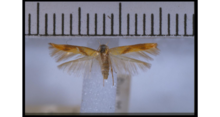mk
имиња во трошки


Die Stathmopoda sind eine Gattung von Schmetterlingen aus der Familie der Stathmopodidae.
Der Kopf ist glatt beschuppt. Die Fühler sind etwa 3/4 so lang wie die Vorderflügel und bei den Männchen bewimpert. Die Labialpalpen sind zylindrisch und gestreckt, das dritte Segment ist stark nach oben gebogen. Die Vorderflügel sind schmal lanzettlich und zum Apex hin zugespitzt. Sie haben häufig eine gelbliche oder bräunliche Zeichnung. Die Hinterflügel sind sehr schmal und gerade.
Bei den Genitalien der Männchen sind Uncus und Gnathos gleich groß. Das Tegumen ist gekrümmt. Die Valven haben einen verdickten Rand, der Cucullus ist kurz und abgerundet. Der Sacculus ist entweder gut oder nur schwach ausgebildet. Das Vinculum ist abgerundet, der Saccus fehlt. Der Aedeagus ist zylindrisch oder distal zugespitzt. Cornuti sind entweder vorhanden oder fehlen.
Bei den Genitalien der Weibchen sind die Apophyses anteriores etwa 1/2 bis 2/3 so lang wie die Apophyses posteriores. Das Antrum ist breit und becher- oder trichterförmig. Der Ductus bursae ist ziemlich breit und häufig runzlig. Corpus bursae mit ein oder zwei Signa. Der Ductus seminalis ist normalerweise lang und schlank und hat häufig verschiedenförmige Erweiterungen. Die Übergangsregion zwischen Ductus seminalis und Corpus bursae ist mit variablen Zähnen oder Nadeln versehen.[1]
Die Arten der Gattung sind weltweit verbreitet und kommen hauptsächlich in tropischen und subtropischen Gebieten vor. Verbreitungsschwerpunkt ist die Orientalis.[1]
Die Biologie ist nur bei wenigen Arten bekannt. Demnach leben die Raupen hauptsächlich in trockenen Blüten, Früchten und Blättern verschiedener Pflanzen.[1]
Die Typusart der Gattung ist Stathmopoda pedella. In Europa ist die Gattung Stathmopoda nur mit einer Art vertreten:[2]
Nichteuropäische Arten:
Aus der Literatur sind für die Gattung folgende Synonyme bekannt:[1]
Die Stathmopoda sind eine Gattung von Schmetterlingen aus der Familie der Stathmopodidae.
Stathmopoda is a genus of moths. It has variously been placed in its own family, Stathmopodidae,[1][2] or in subfamily Stathmopodinae in the family Oecophoridae.[3] Note that the phylogeny and systematics of gelechoid moths are still not fully resolved.
Stathmopoda have smooth heads with a metallic luster, and the occiput may be smooth or slightly coarse. The labial palps (part of the mouthparts) are curved, sharp-tipped and the second and third segments are similar in length. There is a pair of antennae which are shorter than the forewing, have elongate and clubbed scapes, and (in males) the flagella have long ciliae on the anterior margins.[2]
Both forewings and hindwings are lanceolate, meaning they are widest near the base and taper to points at the end. The forewings are usually yellowish with dark brown markings. The tibiae of the hind legs have dense tufts.[1][2]
Most of the abdominal tergites (2nd-7th of males, 2nd-6th of females) have spiniform (spine-like) setae along their posterior margins.[2][4]
The male genitalia have a bell-shaped uncus that is setose laterally and tapering caudally, and is as long as the gnathos. The cucullus is densely setose on its inner margin. The female genitalia have the corpus bursae bearing a signum or a pair of signa.[1][2] See Lepidoptera genitalia for definitions of these terms.
Larvae of Stathmopoda bore into seeds, fruits or buds of plants.[1]
Some are agricultural pests. For example, S. auriferella is a pest of fruits and vegetables including apples, avocados, grapes, jujubes, kiwifruit, peaches and pomegranates. Stathmopoda masinissa can cause serious damage to persimmons.[4]
 Stathmopoda campylocha
Stathmopoda campylocha  Stathmopoda distincta
Stathmopoda distincta  Stathmopoda plumbiflua
Stathmopoda plumbiflua  Stathmopoda skelloni
Stathmopoda skelloni Stathmopoda is a genus of moths. It has variously been placed in its own family, Stathmopodidae, or in subfamily Stathmopodinae in the family Oecophoridae. Note that the phylogeny and systematics of gelechoid moths are still not fully resolved.
Stathmopoda is een geslacht van vlinders uit de familie Stathmopodidae. Stathmopoda hebben erg lange en erg fijne voelsprieten. Er zijn meer dan honderd soorten beschreven in dit geslacht. De pootmot S. pedella is de enige soort die in Europa voorkomt.
De wetenschappelijke naam van het geslacht is voor het eerst geldig gepubliceerd in 1853 door Gottlieb August Wilhelm Herrich-Schäffer.[1] Herrich-Schäffer wees de naam Stathmopoda toe aan Zeller, die de naam in een manuscript had gebruikt.
Bronnen, noten en/of referentiesStathmopoda é um gênero de mariposa pertencente à família Acrolepiidae.[1]
Stathmopoda é um gênero de mariposa pertencente à família Acrolepiidae.